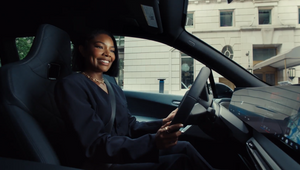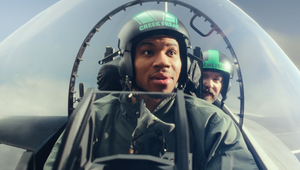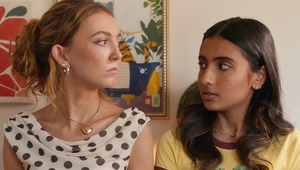
Creative Infiniti on the Volumetric Stage with Kacper Larski

Virtual production techniques have been on the rise since their use in Disney+’s ‘The Mandalorian’ - but the volumetric stage isn’t just home to otherworldly landscapes. Production on a volumetric stage, which involves 360º projections of environments and camera tracking to creative immersive scenery with consistent lighting, is now used across the film industry, on TV series and, of course, on commercial productions too.
Describing the toolset’s ability to produce perfect lighting conditions as “golden hour for days”, Kacper Larski, director at LA-based production company Eleanor, takes us behind the scenes on a recent experience with a volumetric stage.
Kacper’s latest films for Infiniti took advantage of the stage’s capture technology and its ability to produce whatever the mind can conjure, strategically using it to create films shot almost entirely from the inside of a car. Unlike the Mandalorian, which uses 3D computer-generated environments, Kacper used real still photography for the projected backgrounds on the volumetric stage.
LBB’s Ben Conway caught up with the director to hear all about the process.
LBB> What inspired you to shoot on a volumetric stage for this project?
Kacper> Infiniti had a unique story that was told mostly inside of the car. One of the tougher things to shoot in real life is interiors. When you've got a whole script that is in that world, you deal with changing light pretty quickly. We’ve never before been able to shoot a full day in magic hour inside of a car. This technology allowed us to do exactly that. So, we could spend as much time on the moments, the dialogue between people and the features and beauty of the car without fighting with the sun and moving tents around the car.
That's sort of what drew us to using this kind of technique on the ‘Couples Massage’ spot in particular – golden hour for days. It doesn't get any better than that, you know. It's useful for cars, for being inside of a house and controlling your environment, and for a lot of magic realism stuff. If you want a product shot on the moon, you can get it. If you want somebody flying or falling or in some sort of dream sequence, you could do it on a green screen.
There are a bazillion possibilities. It creates this epic studio sort of platform for controlling the sun and weather in a way that we've never been able to do, particularly on interiors.
LBB> Why did you opt to shoot stills of real locations versus the traditional method of virtual production?
Kacper> The traditional method is great for something like ‘The Mandalorian’ or putting your car on Mars, but 3D is not real life. When this tool emerged, for me, I thought it looked too fake. I was always wondering, ‘how can you make it real?’ - and essentially, you're using it as a green screen. You're going to locations, finding real places, photographing them, and then they can be put into Unreal [Engine] anyway, forming a sphere.
For a simpler parallax or the inside of something, you get the real thing - and it is the real location you’ve captured with all its nuances. AI and 3D are amazing, but there's something about perfection that steals us away from authenticity. Taking these real locations gave us the time and budget we didn’t have to build 3D spaces. It gave us a better look and something that’s unquestionably real.
You can push that even further as your budgets and time goes up. You don't have to use stills, you can use video. So you could use 360º cameras and shoot actual videos of locations all around. And then you're going to have birds flying by and trees. There are a few companies that are working on developing that right now - almost stock libraries of locations and 360º videos.
I'm very interested in throwing one of those 360 cameras on top of a car while shooting driving footage. One of the biggest challenges we have is great and safe interior driving footage. We use the process dolly, which is a giant tow truck, essentially, with lights and people hanging off of it.
There's always a lot of police and it's an insane time killer where you could be shooting beautiful driving footage. You can put a techno dolly inside the studio and have a wicked shot instead of, again, some camera just hanging off of a process dolly. You're saving a lot of time and are able to push things a little bit further in terms of movement.

LBB> Do you see a future integration between AI and this evolving technology?
Kacper> I'm sure there's going to be some sort of Midjourney version of Unreal. I think that’s probably a bit of a copyright nightmare because right now the AI's just taking stuff from everybody and chopping it up. But essentially, that's what we humans have been doing too!
It's definitely going to be an option, and quite a cool one - for testing too. And while the studio is expensive, in a sense, it's not much more than any other studio day, and it's controlled. You can do a lot of testing at not an incredibly high cost and, and really push the boundaries of what your story is or where it's taking place.
LBB> Did you work with the production designer any differently than you would on a standard commercial?
Kacper> I think the luxury we had on this one is that our locations were real. So, my process with Lindsay, the production designer, was mainly about the real spaces. We picked our spot where we were going to pseudo ‘park our car’, and had the luxury of being in a not real space… but for real. The production design experience was similar. Using stills, we had a lot of trees around us and those weren't really moving, so we actually did end up bringing in some trees and bushes into the studio and shooting lights through them so that there were shadows that had like a flicker ring.

LBB> What other benefits did this process have for the production?
Kacper> In a lot of car commercials, you do field interior work due to safety and all that stuff. The interior world has always been rushed. There’s limited space, limited time. There’s lots of people yelling, kicking and screaming in between the police, the actual traffic and everything else. It just doesn't create an environment for an actor to get into the mentality that we want them to.
So, you throw somebody into a green screen room and say, ‘Okay, you're driving on a mountain road’. It's a bit of a ridiculous task, but it was great chatting with the actors on set and seeing how easily they were able to get into their roles. The crew's energy definitely comes through on set. It’s the Peter Pan thing - everybody has to believe in order for this to work and, in this studio, it's like everybody believed they were all there.
LBB> Are there ways you're hoping people will start using the volumetric stage in the future? Or ways that you think this technology will evolve over time?
Kacper> I think the volumetric stage will just get bigger. There's obviously still no such thing as a 360º screen. So there are gaps and overlaps that you have to avoid. But generally, it's pretty epic. I mean ‘The Mandalorian’ is a great example of how far you can already go. So, how much further? I don't know.















